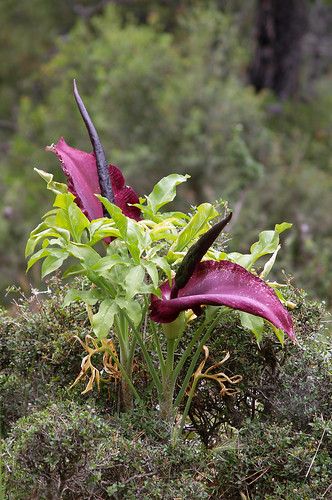
(Photo by Jörg Hempel)
It is amazing just how so many different creatures can be associated with dragons for some really spurious reasons. Take for example, the chinchillas (Chinchilla spp.), whose Chinese name of 龙猫 ('dragon cat') is due to the fact that they resemble a Japanese anime character who bears that same name in Chinese translations. Or the dragon trees (Dracaena spp.), named after their reddish sap that was extracted and marketed as the blood of mythical reptiles. And don't get me started on dragon fruit (Hylocereus spp.); the only possible link with dragons I think of comes from the apparently scaly fruits and spiny succulent stems.
With the various flowers named after dragons though, the connection with the mythical fire-breathing reptiles turns even more tenuous.
The dragon arum (Dracunculus vulgaris), also known as the voodoo lily, is an aroid that grows in the Balkans, Greece, Crete, and southwestern Anatolia in Turkey. It has also been introduced to parts of the United States. In Greece, the plant is known as drakondia, with the long spadix (or spike) being viewed as a small dragon hiding in the spathe (the modified petal-like leaf). Don't ask me, that's what Wikipedia says, and this factoid is repeated in a number of other sites. Anyone from Greece able to verify this claim?
In any case, the dragon arum has a shape that's commonly found in aroids. Think of it as a miniature version of the titan arum (Amorphophallus titanum), which I wrote about back in December 2010.
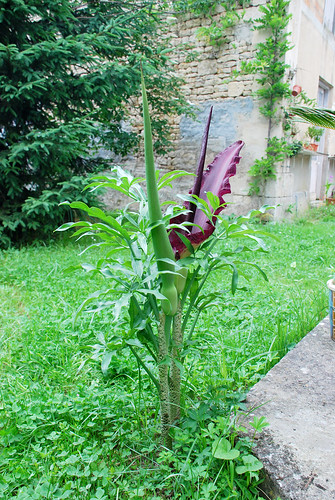
(Photo by Mafate79)


(Photos by JohnS2233)
Like the titan arum and many other aroids, the dragon arum gives off a foul smell reminiscent of rotting meat, which attracts carrion flies that serve as pollinators. The dragon arum also 'traps' the flies that visit; they slide down the smooth surface of the spathe, and are unable to crawl up and fly out of the flower. In the meantime, they wander around helplessly over the surface of the stigma of the female flowers at the bottom, fertilising them with pollen gathered from other flowers. A day later, the anthers open, dusting the flies with pollen, while the rest of the flower begins to wither, and the flies are freed to visit and pollinate other flowers.

Note the flies on this dragon arum flower;
(Photo by Brian (aka treehugger_007))
More information about the dragon arum can be found here at this page by the International Aroid Society, as well as this page with plenty of photos.
The dragon arum has a relative known as the Canary dragon aroid (Dracunculus canariensis), which has white flowers, and is endemic to the Canary Islands and Madeira in the east Atlantic.
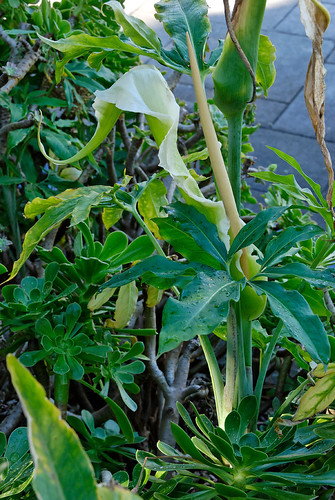
(Photo by Tony Rodd)
Another flower that owes its common name to the mythical fire-breathing reptiles is the snapdragon (Antirrhinum spp.), of which there are more than 30 species found in the Mediterranean region as well as in California. The common snapdragon (Antirrhinum majus), originally native to the Mediterrranean region from Portugal and Morocco east to Turkey and Syria, is popular as a garden ornamental.
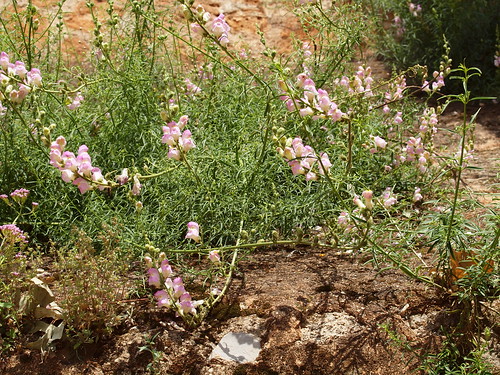
(Photo by Peter Greenwoods)
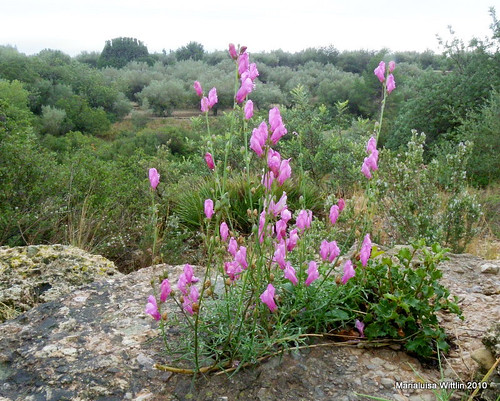
(Photo by Marlis1)
The name 'snapdragon' comes from the fact that squeezing the 'throat' of the flower causes the petal 'lips' to open.
Apparently, people love to upload videos of them using snapdragon flowers as miniature talking and singing puppets. Oh, my sides.
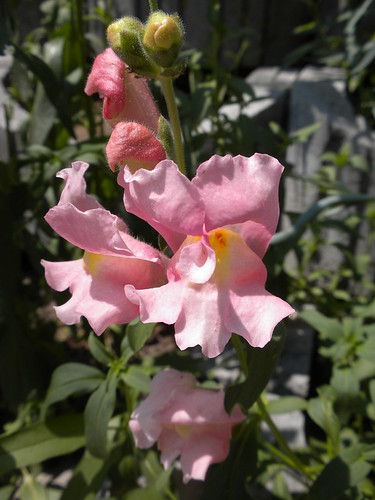
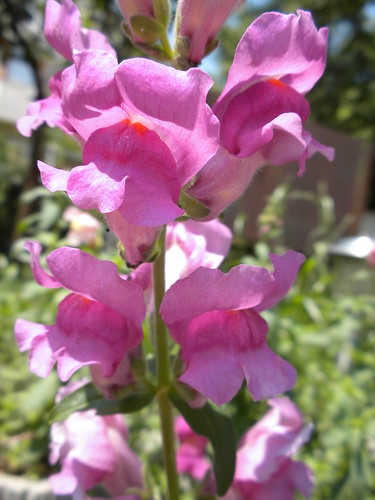
(Photos by eszsara)
Besides dragon arums and snapdragons, there are also orchids that have dragon-based names.
The dragon's mouth orchid (Arethusa bulbosa) grows in bogs, swamps, and other humid areas of eastern North America.
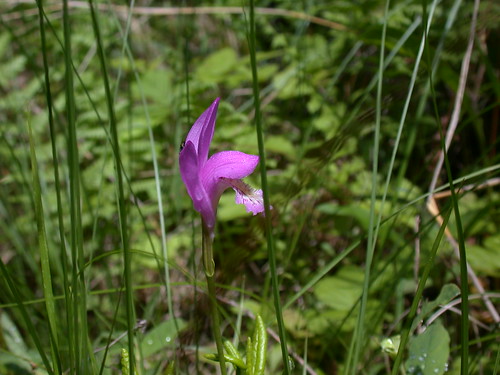
(Photo by Native Orchids)
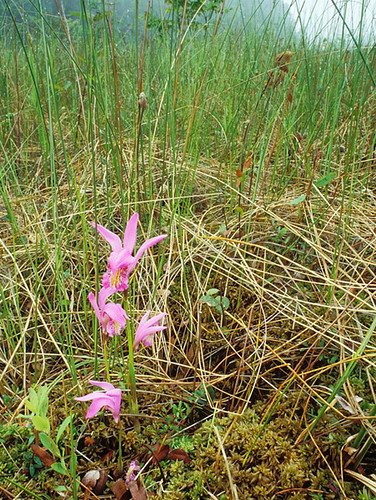
(Photo by ER Post)

(Photo by golforchid)

(Photo by sloanbj)
While the dragon orchids (Caladenia spp.), represented here by the common dragon orchid (Caladenia barbarossa), are a group of 4 species endemic to western Australia, sometimes split off in their own genus (Drakonorchis).

(Photo by Madfish WA)
The dragon orchids (and several other orchids) actually rely on deception to attract the insects that they rely on for pollination. In flower wasps (F. Thynnidae), the flightless female crawls to the top of a stem, and attracts the male by releasing pheromones. The male flies in, carries her off, and they copulate. The dragon orchid has a strangely-shaped labellum (or lip), that is actually supposed to resemble the abdomen of a female flower wasp. The orchid even gives off pheromones similar to those released by the female flower wasp! As a result, a male flower wasp soon flies over to investigate. When he grabs the labellum and attempts to fly off with it, thinking that it's a receptive female, the hinged labellum flicks the male wasp against the main column of the flower, pressing him against it momentarily. When he flies off, confused, he carries pollen from the dragon orchid attached to his back. Should he fall for the same trick and visit another dragon orchid, the pollen he is now carrying will fertilise the other orchid.


In this series of photos, a male flower wasp is first flicked against the pollen-bearing main column, with the pollen visible in the second photo;
(Photos by Mitsuhiko Imamori, from AnimalsandEarth)
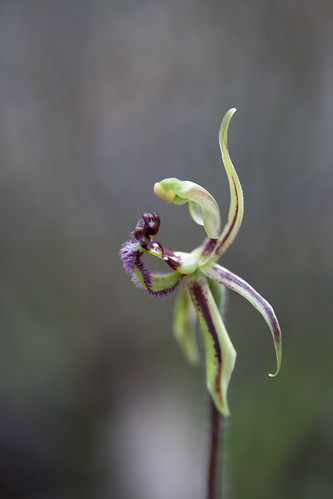
(Photo by Briarah - aka Tina)
I'm not sure if there are any more flowers named after dragons. Honestly, the connection is weak, but I guess naming an organism is as much about one's creativity and imagination as it is about describing said organism's distinctive physical features.
Next up: Back to animals, and this time, we'll take a look at some very dragon-like creatures that live underwater.